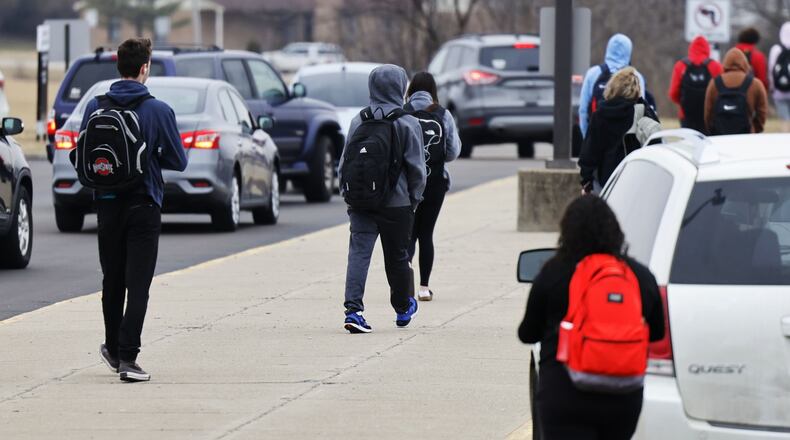And a recent Ohio survey of K-12 public schools — done with help from Miami University — reveals 75% of survey respondents reported “increased concern for moderate or severe depression, significant anxiety and social isolation among students.”
Moreover, nearly 60% of survey participants to the Ohio School Wellness Initiative also reported “increased concern for suicidal (thoughts), attempts and trauma exposure (including Post Traumatic Stress Disorder).”
And long before the onset of the COVID-19 in March 2020, alarms over the state of student mental health had been sounding, with all local schools scrambling to bolster their school resources to help troubled children and teens.
Then the onslaught of the potentially deadly virus, its subsequent and sweeping ramifications – first closing all schools, then remote learning, later forcing masking, quarantines and other measures – multiplied mental health stressors to unprecedented levels, say area school counselors and mental health experts.
“We already knew levels of anxiety and depression were rising before the pandemic, so to have an increase on top of that is a huge concern,” said Kristy Brann, a Miami University assistant professor of school psychology.
“Almost across the board there are increases in anxiety and depression, and large increases with social isolation and suicide,” said Brann.
Brann is part of a Miami team of researchers and statisticians overseeing OSWI, which recently received $6 million from the Ohio Department of Education to aid mental wellness for Ohio K-12 students and staff.
Mason Schools counselor Michelle Krugh has worked in the district for 24 years but none of that prepared her the jump in mental health problems among students that came with the pandemic.
“It was a huge spike. And we’ve all been impacted by this trauma,” Krugh said of COVID-19′s effect on students.
Some area schools — including Mason — had “Hope Squads” — anti-teen suicide organizations designed to act as bridge in helping get troubled high school students — prior to COVID-19.
But even more schools have the squads now and Fairfield High School Senior Kennedy Baker, who has been part of the school’s Hope Squad for two years, said the teams proved even more vital from the pandemic’s start.
Prior to the virus’ onset, Baker tells the Journal-News she estimated about 10 percent of her classmates exhibited some signs of mental health stress and possible candidates for counseling.
Since COVID-19, that percentage, she estimates, has doubled to 20 percent.
“It rose after the pandemic started,” she said.
In other ways the pandemic has transformed and expanded the safety net mental health services offered by area schools since the start of the 2020-2021 school year.
Beyond the Hope Squads, more schools now have a higher number of counselors — important first contact personnel for troubled students seeking to be referred to professionally licensed mental health therapists.
And therapy dogs, once a relative novelty, are more common now and especially popular among elementary grade schools.
Matt Miller, superintendent of Lakota Schools’ 17,000-students, said the recognition of mental health needs of students wasn’t discovered at the onset of COVID-19 and that the pandemic only accelerated awareness.
“Ensuring that our students have access to mental health resources in our schools was established well before the pandemic,” said Miller.
“While COVID has certainly impacted our families and staff, having resources like mental health therapists through our partnership with MindPeace, our counselors, Hope Squads and therapy dogs helps us help our students through this trying time.”
Lakota East High School senior August Whitton, whose is a member of her school’s Hope Squad, described the pre and post-pandemic changes in stress levels among her classmates as stark.
Whitton joined many other of her classmates since 2020 in occasionally using the mental health services made available.
“Everybody is supportive, understanding and really helpful.”
Whitton said the counseling was “100%,” welcomed and useful.
“I don’t know where I would be at without them. It’s good to lean on people when you need to.”
Lakota East Counselor Andrea Bryant said “the pandemic has definitely put a different layer of stress — and overall mental health concerns — and put the pressure on a lot of our students as we came through it and hopefully are coming out of it.”
Bryant praised the literally life-saving role of Hope Squad student members who assisted some classmates who exhibited possible suicidal tendencies and got them to professional therapists.
“We have been able to link them with the correct resources and to help them with their mental health and to save their life from wanting to end it,” she said.
COVID-19 stress weapons: Dogs, more counselors, therapists and lots of empathy
Therapy dogs, once a relative novelty, are more common now and especially popular among elementary grade schools.
The furry creatures are much more than cute, said Krugh.
“They (dogs) can change a mood in seconds because unconditional love from a dog can really make a difference among students,” she said, noting all Mason schools now have therapy dogs.
Bryant described the specially trained and caring canines as “fantastic,” and now more prevalent in Lakota schools.
Counselors have long been the main connector to area mental health therapists for students who reach out during the school day seeking psychological aid.
Almost all area schools have contracted with local hospitals or therapy counseling services that accommodate referrals from school counselors and school families for troubled children and teens.
“We as school counselors, we are on the frontlines of this. What we saw before (COVID-19) was often generalized anxiety. But what we saw since and what we are seeing now is more intensive anxiety and depressive symptoms, sometimes even PSTD (post-traumatic stress disorder),” Krugh said.
Amy Macechko, health and wellness coordinator for Talawanda Schools, reminds those who ask her about teen stress during pandemic that it’s a naturally turbulent time for youth.
“Being a teenager two years through a pandemic is a lot for our students to manage. The amount of loss of opportunities and experiences. In the mind of an adult it’s hard but we have a fully grown brain that can say there is going to be an end to this,” said Macechko.
“But in a teenage brain that is not fully developed, that is their everything,” she said.
As the number of COVID-19 cases decline, Bryant said there is more optimism among students.
“I do believe we are hitting a bit of a plateau or leveling off. Students are feeling more confident that things are not going to drastically change and the rug is not going to be pulled out from underneath them and that stability is important,” said Bryant.
“And that stability provides a safety net to lessen some of that stress.”
About the Author

